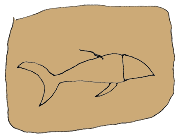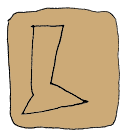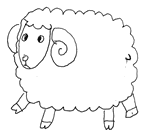Prehistory ends and history begins with the incredible invention of writing, which happened both in Mesopotamia and Egypt around 3200 BCE as a means to record economic transactions. Early writing basically has five stages:

The earliest writings were like totally pictographic. Thus, if some dude named Gilgamesh owed some dude named Narmer thirty fish, they would draw a picture of a fish on thirty separate tokens as a receipt or contract.

Then something totally awesome happened. They decided that rather than make thirty tokens, they could simply draw thirty fish on one clay document.

Absolutely astounding, my darlings. Then writing became logographic, which is simply a fancy way to say that these pictures came to symbolize not only the item depicted, but associated items as well.

Let me give you an example, this pictograph of a foot now meant not only "foot," but also things like "walk," "stand," and "carry."

But that system remained limited, as one couldn't write abstract concepts such as "love" or "truth," or write a person's name. So to fill these needs writing became phonetic, and this was based on homophones.

That is to say, a picture of a female sheep might represent "ewe," "you," and "eeuuuuw," the sound children make after eating worms.
This is the same principle behind a rebus like the one below. See if you can decipher it.
![[Rebus]](../images/illustrations/rebus.gif)
![[Mike]](../images/mike/happy_1_right.gif)
It was then, to the delight of my second grade teacher Ms. Crankengrumpus, that writing became grammatical. They simply added prefixes and suffixes to words to create grammar. So, if you like took a picture of a foot and added the prefix "e," it now meant "he walked." If you then added the suffix "esh," it meant "they walked."
But there was still a problem that needed a totally non-bogus solution. There were too many homophones and deciding which meaning was meant was like wayyyyyy confusing.
The solution??? Determinatives, dude! They simply put a picture known as a determinative before the word to give it some context. Thus to determine that a picture of a sheep represented a "ewe," the writer added a picture of an animal determinative, or to determine that a picture of a sheep represented "eeuuuuw," they might add a determinative of a kid holding their nose.
![[Kid holding nose]](../images/illustrations/kid_holding_nose.gif)
![[Sheep]](../images/illustrations/sheep.gif)

Oh Baloney! Enough about phonetics, logographs, worms, determinatives, sheep and grammar school teachers! I happen to know the invention of writing involved cuneiform and hieroglyphs, neither of which you've mentioned!

Correct you are, Methuselah. But those are ancient writing SYSTEMS invented in about 3200 BCE and used for more than 3,000 years. The last known cuneiform inscription dates to about 75 CE, hieroglyphics about 100 years later. And I should explain that the terms "cuneiform" and "hieroglyph" are relatively modern designations-neither was used for these writing systems in antiquity. As you can see in the chart below, in Mesopotamia the pictographs became quite stylized over time.

First they rotated the pictograph 90 degrees counter-clockwise, likely because of the way the scribe held the tablet shifted. Then eventually they used wedged-shape (Latin: cuneus form) writing, and in time the original pictograph became unrecognizable.
In Egypt, their writing system was later called Hieroglyphics (from Greek hiero, meaning "sacred," and gluphe "carving"), as people thought these ancient Egyptian pictographs held a sacred quality.

While Egyptian hieroglyphics changed little over time, other writing systems in Egypt, such as hieratic and demotic greatly simplified and stylized the original hieroglyphic pictographs.


And then, like around 1400 BCE, along came my favorite invention, the ALPHABET! You might imagine like how it was totally painful and not to mention time killing to learn the thousands and thousands of cuneiform or hieroglyphic signs necessary to read and write. So some Canaanite dude with connections to Egypt made life easier for a bajillion people after him by inventing a writing system based on acrophonic principles. This simply means that the first sound of a word is represented by a picture of the word. Let's let these letter dudes help explain.

Howdy, BibleDudes. So this guy that invented the alphabet took the pictograph for a bull that you see below.

Well, in his Canaanite language he pronounced bull alpu, and he decided that anytime he needed to write an "a" sound, he'd just draw the picture of a bull. That was my ancestor, and you can still see the two horns on the bottom of me. The Israelites adopted the Canaanite alphabet, and in Hebrew this letter is called 'alef or ℵ, and the Greeks, who also based their alphabet on an earlier Canaanite one, called the same letter alpha or α.

Cool, A, and as for me, I was originally a picture of a house. The Canaanite dude that invented the alphabet called a house bet. So, from then on, because of the acrophonic thing, the house pictograph represented the first sound of bet, or "b." The Greeks called the letter beta or β. Here's a chart of my history.

Incidentally, the English word "alphabet" comes from its first two letters, in Greek: alpha + beta.

Astounding, my darlings, and what's more — The alphabet democratized civilization. It put the powerful ability to read and write into the hands of a great number of people. And this factor greatly influenced the Bible. Whereas most ancient Near Eastern literature goes on infinitum in praise of the king, the authors of the Hebrew Bible are often outspoken in their criticism of government. This level of criticism is something you would never expect in places like Egypt and Mesopotamia that used non-alphabetic writing systems, as their scribes were among society's elite, having trained for many years and often on the king's payroll.
![[Jeff]](../images/jeff/scroll_1_right.gif)
Excellent point Cleopatra. That's one of my favorite things about the Bible — at times the authors are painfully truthful.
And that brings us to what I'm now holding in my hands: a scroll. The earliest biblical books weren't books at all, but they were writings like this, consisting of either leather or papyrus rolled up around wooden dowels. In fact, our word "paper" comes from papyrus. In Egypt they used to take thin strips from the papyrus plant, lay them out in cross sections and then press and dry the material to form thin sheets.
Typically scrolls were about 12 to 18 inches in height, and as much as 30 feet in length. Scribes would write in vertical columns on the scroll, and when you wanted to find a certain passage, say in the scroll of Genesis, you would unroll it to that section. The act of rolling was so integral to this process that the Hebrew word for scroll, megillah (plural: megillot), comes from a word meaning "to roll."

Yeah, right. Three questions:

You're like right on with the first two questions. And, indeed, Methuselah, the size of the scroll like totally matters.
You see, the most you can fit on a typical scroll is about 25,000 words. So, in the Hebrew Bible's shorter books, such as the 12 Minor Prophets, they put all of them together on one scroll. And long books like Samuel, Kings, and Chronicles nearly maxed out the scrolls, as each consists of about 25,000 words in the original Hebrew.
I should also add that Hebrew is like a completely economical language. It is written for the most part without vowels, and you can say a lot in Hebrew using only a few words. Then something awesome happened: they translated the Bible into Greek, which wasn't such an economical language.
Here you can see the first sentence of the Hebrew Bible written with 28 Hebrew letters or 38 Greek:
![[Genesis 1:1 in Greek]](../images/illustrations/genesis_1_greek.gif)
In Greek, larger books would no longer fit on one scroll, and thus they had to divide them up into two scrolls. That's why today we speak of 1 and 2 Samuel, 1 and 2 Kings, and 1 and 2 Chronicles.
![[Mr. Bible]](../images/mrbible/mrbible_1_left.gif)
At some point in the 1st century CE, someone got sick and tired of having to roll and unroll scrolls whenever they wanted to read a passage. And, as necessity is the mother of all invention, the first book, or more properly, the first codex (Latin for "book") was invented. They simply took several pages and bound them together along one edge, called the book's spine. Now reading and finding passages was much easier and faster. But it was still difficult to reference passages, as the biblical books were not yet separated by chapter or verse. That's why I'm so happy to introduce to you Mr. Bible Chapters himself, the 13th century Archbishop of Canterbury, Stephen Langton.
![[Stephen Langton]](../images/other/langton_1_right.gif)
Thanks Mr. Bible and BibleDudes. Before I became Archbishop I was a theologian in Paris working on a Bible concordance, and I needed a way to divide up the Bible beyond just the name of the book. So I assigned chapters to the text, and my divisions were soon thereafter adopted by Jewish and Christian sects, and remain intact today. About 300 years after me, in the 16th century, scholars assigned verses to the text, also as a means of standardizing reference. Once in a great while, however, these verse divisions don't quite make sense, as they come mid-sentence. Legend has it that the guy assigning these divisions used a pen while reading the text on horseback, and when the horse excessively bumped him, he made the mistakes. The important point here, beyond not doing your homework while riding horseback, is that the divisions of the Bible into chapters and verses is secondary — So if you feel an idea continues into the next verse or chapter in the Bible, you may be right.

Fascinating, my darlings. In the next section we'll learn the difference between an MT, an LXX, and an RSV as we examine the incredible world of Bible translations.